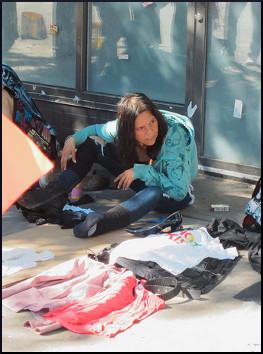
Last week we looked at some of the life problems that particularly affect homeless youth, in the cauldron of social unrest known as California. Although these conflicts are more evident in that state because of sheer numbers, they exist in all American cities.
Among the righteously housed folk, anti-homeless laws are known by the politically correct term “quality of life ordinances.” Always the big question is, whose life? For housed people who dislike the chaotic ambiance of urban streets, there is a place to escape to and shut the door on it. “Unaccompanied” young people don’t have the luxury of that alternative.
The California Homeless Youth Project report says:
The use of “quality of life” as a characterization of such policies fundamentally excludes the lives of people surviving on the streets.
Such policies are in fact discriminatory and abusive, and they provide far too many occasions for contact between street kids and law enforcement personnel. This is unfortunate, because the odds are against any one police contact turning out well, and the more contacts, the worse the odds become.
At the very least, officers will probably demand that kids “move along,” and in most cases that involves relocating from populated and relatively safe areas to more isolated and dangerous patches of territory. At best, it’s harassment, and at worst, an invitation to disaster. The same report quoted Ric Declan, an Oregon police sergeant with a maverick spirit, as saying:
We know that homeless youth are more often the ‘victims’ rather than the ‘perpetrators’ of crime and should be treated as such.
The authors of that document also noted that “not one youth interviewed reported ever turning to police for help when they needed it.” What does that say about the often-mythical slogan “Protect and Serve?”
When a community is allowed to enforce rules that violate basic human rights, nobody wins and everybody loses. Tax revenues are used to extend police hours into overtime, open more courtrooms, hire more guards, pay more public defenders, and rent more space in penal institutions for people whose initial crime is having nowhere to live. Laws that criminalize homelessness are so counterproductive they can do nothing but make situations worse—not only for the people convicted, but for society as a whole.
The tragedy of all this is multiplied when young people are the targets. They are already teetering on the edge of oblivion. Even a teen with a full complement of parents, extended family members, teachers, and coaches can have a rough adolescence. Imagine how much more difficult it is to grow up in the middle of nowhere, with no support system, and surrounded by predators. No kid needs a criminal record, which is likely to become Step 1 in a career of recidivism. Maria Foscarinis, Executive Director of the National Law Center on Homelessness and Poverty, says:
Laws criminalizing homeless youth deprive them of the opportunity to succeed in life, creating additional barriers to housing, employment, and education, and only serve to punish them at a time when they are most vulnerable.
These things (again, according to the California Homeless Youth Project) need to be done:
- Decriminalize necessary human behavior that occurs in the absence of alternatives
- Create a continuum of housing options
- Convene community forums to facilitate dialogue among service providers, law enforcement, business owners and associations, and homeless youth
- Increase resources for homeless youth
- Create Homeless Outreach Teams that are trained to respond to the unique circumstances of homeless residents
- Address need for affordable transportation
Other than mentions of mental health and substance abuse, the list of high-priority policy recommendations does not include physical health care outreach. House the Homeless hopes to see it join the list.
Reactions?
Source: “Adding Insult to Injury: The Criminalization of Homelessness and Its Effects on Youth.” September 2015
Image by urbansnaps – kennymc


